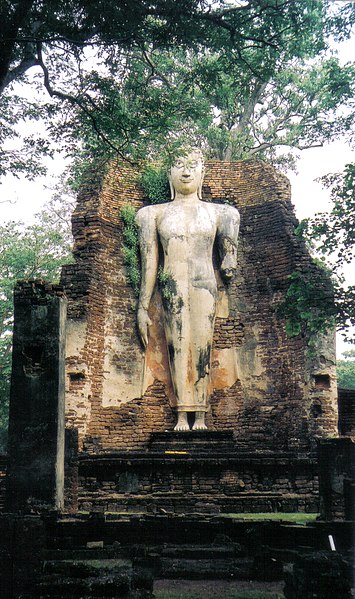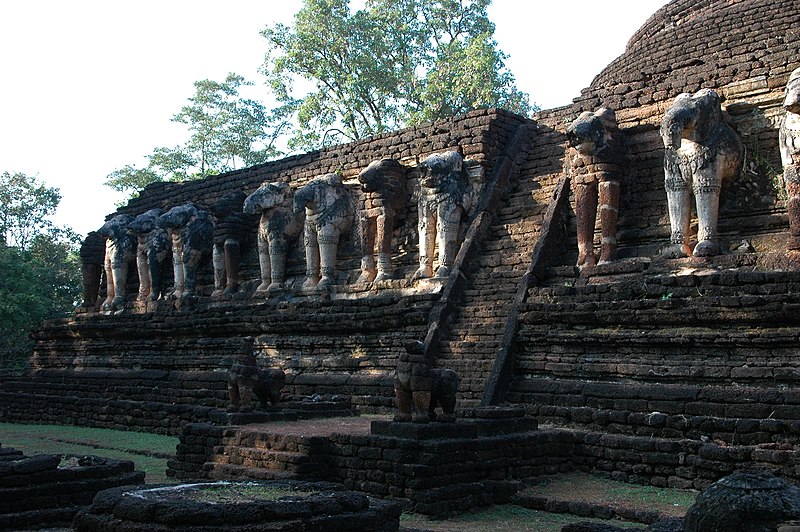Kamphaeng Phet Historical Park (Thai: อุทยานประวัติศาสตร์กำแพงเพชร) is an archeological site in Kamphaeng Phet, Thailand. Along with Sukhothai Historical Park and Si Satchanalai historical park, it is a part of the UNESCO World Heritage Site Historic Town of Sukhothai and Associated Historic Towns. Major features in the Kamphaeng Phet Historical Park include archaeological remains of ancient sites such as Mueang Chakangrao to the east of the Ping River, Mueang Nakhon Chum to the west and Mueang Trai Trueng some 18 km from the town to the southwest. Chakangrao, the ancient Kamphaeng Phet town, had the same town planning concept as the old Sukhothai and Sri Satchanalai, with separate zones for religious sites both within and outside of town limits.
Religious sites on the west bank of the Ping River at Nakhon Chum are built of bricks and of smaller size. City walls and old fortifications mark the boundary of the rectangular town area, measuring 300-700 metre wide and 2,200 metre long.
Almost all ancient buildings and monuments in the old town of Kamphaeng Phet were used as religious places for Theravada Buddhism (originating from Sri Lanka). According to many stone inscriptions from the Sukhothai period and some architectural and sculptural evidence, Kamphaeng Phet was found in the same period of Sukhothai during the late 15th century AD, or otherwise known as being after the reign of King Ramkhamhaeng.
Wat Phra Kaeo (วัดพระแก้ว) is a large royal temple in town centre near a site believed to have been a palace. The temple itself was used on important city events and had no monks in residence. Major features include the principal Chedi with lion-adorned base and a round Chedi with elephant-adorned base. There are also other Chedis of different bases and remains of several chapels. Its boundary is marked off by laterite walls. The layout of this temple is very rare to find, placing the reclining Buddha image in front of the two sitting Buddha images, and so it has become one of the most appealing tourism symbols of Kamphaeng Phet that definitely should be visited.
Second in size to Wat Phra Kaeo is Wat Phra That (วัดพระธาตุ). Here the principal Chedi is built of mixture of laterite and bricks with a 15-metre wide square base. The style is of Kamphaeng Phet architecture.
Sa Mon (สระมน) is the site of the palace located to the north of Wat Phra Kaeo with a square earthen wall almost touching the northern city wall. Surrounded the walls on three sides are moats with a pond in the middle. There are no standing structures remaining today.
 Wat Phra Non (วัดพระนอน) is fenced in by laterite walls on four sides. At the front of the temple are a square-shaped pond, bathrooms and an ancient floating pavilion which is supported by a large laterite column. The entire column was cut out in one single piece from its source and measures 1.1 meters on each side and 6.4 meters in height, the largest such stone in the country. A lion sculpture and Sema stones (boundary stones) can still be discerned. The large Vihan which once housed the Reclining Buddha has crumbled entirely.
Wat Phra Non (วัดพระนอน) is fenced in by laterite walls on four sides. At the front of the temple are a square-shaped pond, bathrooms and an ancient floating pavilion which is supported by a large laterite column. The entire column was cut out in one single piece from its source and measures 1.1 meters on each side and 6.4 meters in height, the largest such stone in the country. A lion sculpture and Sema stones (boundary stones) can still be discerned. The large Vihan which once housed the Reclining Buddha has crumbled entirely.Wat Phra Si Iriyabot (วัดพระสี่อิริยาบถ) is located to the north of Wat Phra Non and have similar pond and bathroom facilities as its neighbour. Walls on the four sides are of laterite materials with an entrance also made of laterite. A Mondop structure houses Buddha statues in four postures-walking, sitting, standing and reclining. But only one big standing Buddha image on the south of the chapel remains until today, showing a harmonious mix of Sukhothai and Kamphaeng Phet art and architecture.
Wat Phra Sing (วัดพระสิงห์) is believed to have been constructed during both the Sukhothai and Ayutthaya periods. With laterite walls, it has a square-shaped principal Chedi with arches on four sides. In front of the Ubosot are ornamental lion and Naga figurines.
Wat Chang Rob (วัดช้างรอบ) is a large temple situated on a high hill. As its name suggests, Wat Chang Rob means “the temple surrounded by elephants”. Its main chedi of Ceylonese style is in the middle of the yard but its top part is broken down. The base is adorned with 68 half-elephants between which are Bhoti-shaped designs. There are also traces of demon and female dancers’ figures remaining.
Kamphaeng Phet Historical Park might not be one of the most major destinations for tourists, as it’s likely to be just another sleepy old town and it is does not seem so appealing to passersby. However, Kamphaeng Phet historical site – especially in the forest areas outside the old town is one of the places should be visited. Therefore, locals and foreigners should be alike to visit and support the maintenance of this truly beautiful historic site.
Images: http://commons.wikimedia.org/wiki/Category:Kamphaeng_Phet_historical_park














0 comments:
Post a Comment